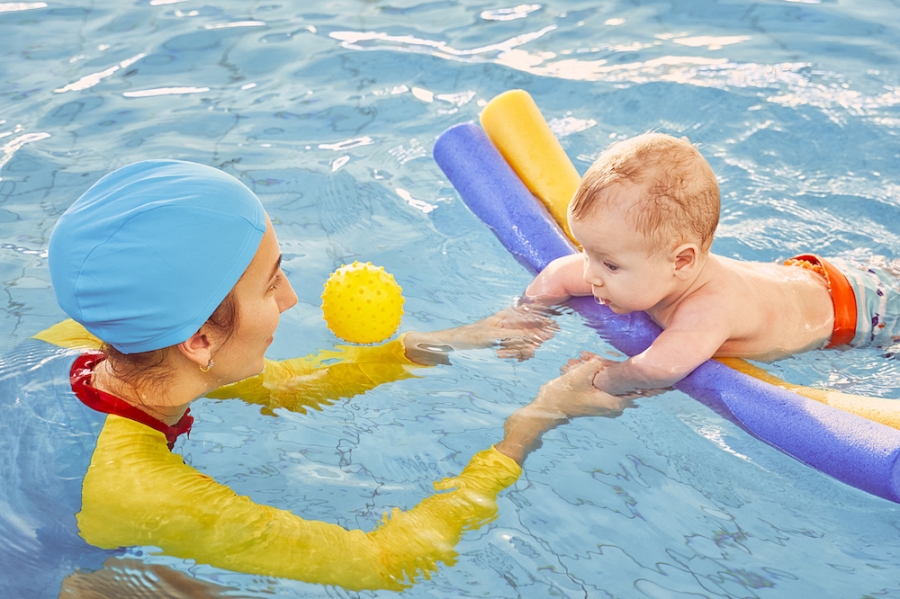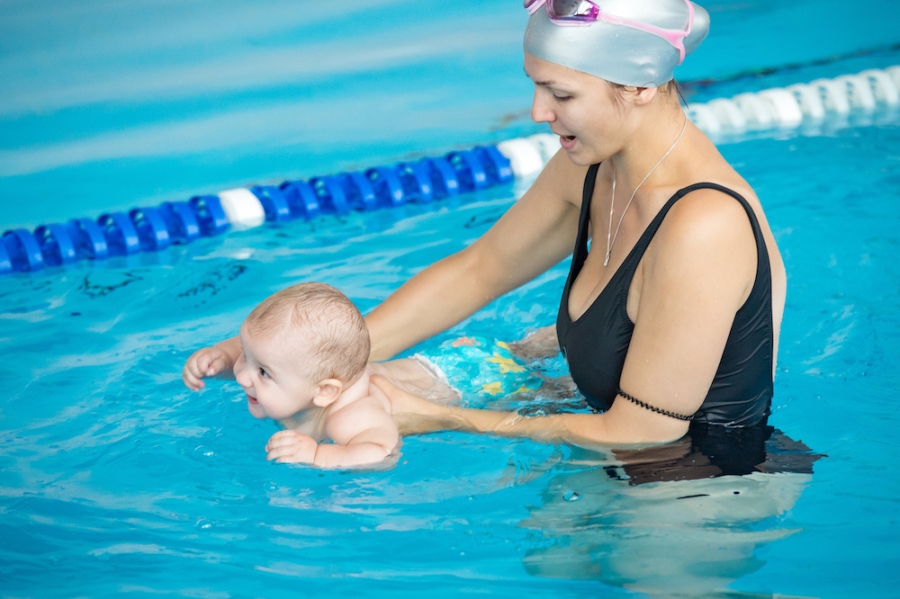From floating to breathing techniques, swimming is an essential life-saving skill that you can teach your child even from a very young age. All of these amount to self-rescue training in preparation for open bodies of water.
The first step to learning how to teach a baby to swim is understanding the basics of swimming.
And while you can handle the basics, Peace of Mind Swimming’s one-on-one private swim lessons will ensure your kid knows the best water safety habits.
How To Teach a Baby To Swim
Babies are yet to develop much of their motor skills, so you will find that adult swimming is very different from baby swimming.
In fact, you might have noticed how trainers have a different set of instructions for their infant swimming programs.
Water survival skills training is also different for toddlers, as they already understand simple verbal instructions.
When swim schools teach infants to swim, repetitive actions make babies acquire skills that make them unwittingly adapt to every unique situation.
Here are a few tips to consider before teaching baby how to swim:
1. Set Your Expectations
When teaching a baby how to swim, it is vital to set your expectations. While swimming can come out quickly as a natural skill for babies, some will still need time to get used to the water.
Being attentive parents is always crucial for safety, and your expectations will tell you when to move forward or when to stop.
Since swimming is important for child water survival, you should be willing to commit to the teaching and learning process. Sometimes, you or your child will not be in the mood for swimming.
2. Start Them Young
You might have come across someone saying that babies are excellent swimmers, but that is not the whole picture.
It is not true that babies are born with an innate ability to swim just because they have been floating in amniotic fluid for nine months.
However, babies have natural-born reflexes that give them an advantage in the water.
As such, it is good practice to start them young.
Language development is out of the question at this stage, and you will have to depend on their reflexes to become innate abilities over time.
3. Learn About Baby’s Innate Reflexes Beneficial for Swimming
The American Academy of Pediatrics says that swim lessons for children ages four and below do not eliminate the risks of child drowning. Therefore, it is imperative that you give your child close supervision when in and out of the water.
When learning how to teach your baby to swim, the following innate reflexes can come in handy:
Diving Bradycardia or Mammalian Dive Reflex
The mammalian dive reflex is a bradycardic response that makes babies open their eyes and hold their breath underwater. A parent can test and cause the same reaction by blowing in their baby’s face. This reflex usually disappears after six months from birth.
Amphibian Reflex
The reflex that makes babies kick or wad their legs in water is called the amphibian reflex. It comes as an automatic response from placing your baby’s tummy and face down in the water. This reflex diminishes around the time they get to four months.
Palmar Grasp Reflex
Babies are also born with a response called the palmar grasp reflex, which makes them grip and hold on to objects. You can use this reflex to promote the life-saving skills of gripping, grabbing, and holding on while swimming.
To test this reflex, press one of your fingers on the palm of your baby’s hands, and see if they will grip tightly. The palmar grasp reflex usually diminishes around three months from birth.
4. Learn Your Swimming Basics
First of all, you cannot possibly teach something that you, yourself, do not understand. If you do not know the basics, hiring an experienced swim coach from Peace of Mind Swimming is always better.

These professionals are trained to teach infants to swim and enjoy the experience.
Then again, as the parent, you will also need to master at least the basic water survival skills, which include the following:
Water Comfort
The most important and probably the most basic swimming skill is simply being comfortable while in water.
It is not advisable to attempt teaching your baby to swim if you have developed aquaphobia.
While it is typical for babies to experience unintentional submersion, a trainer with a personal fear of water can make things worse.
If you are not comfortable in the water, you might start panicking, which gets in the way of critical thinking. And without critical thinking, you might not be able to prevent your child from drowning.
You can become more comfortable in the water by spending more time in bathtub water, a shallow area of your backyard swimming pool, or along the shore.
Proper Breathing Control
Recall your first swim lessons and try to remember how difficult it was to breathe with water splashing all around. Now, imagine how your baby reacts whenever you bathe them.
Do they make sudden movements that lead to excessive water splashing, or are they calm and relaxed around water? Knowing these details before teaching baby to swim increases the chances of learning how to properly breathe while swimming.
When learning how to teach your baby to swim, the key is to promote proper breathing control by creating a relaxed environment. Sometimes, happiness in bath time can lead to excitement that eventually causes unintentional submersions.
Floating
While learning how to float can be tricky for many adults, a baby under six months has a lot of fat in their bodies that make their belly float naturally. Of course, this reflex only kicks in when they are calm and relaxed. Nevertheless, a baby’s nine-month stay in a womb makes water in their ears feel natural, making them happy to relax in the water.
Kicking and Strokes
While kicking and hand strokes are the first skills you learn in swimming lessons, they may come as natural reflexes for babies. This makes teaching baby to swim a bit different from older kids. When you position your baby on their abdomen in the water, the amphibian reflex will sometimes cause their arms and legs to move.
Body Coordination
Relying on the amphibian reflex of babies promotes muscle development and body coordination. As soon as a baby presents signs of language development, you can use verbal instructions to improve water movement skills. When your baby grows into a toddler, you will have to enforce body coordination for breathing and movement as you go along your swimming sessions.
Baby’s First Swimming Lesson
Learning how to teach a baby to swim is pretty straightforward if you have the right set of skills to teach.
Spending time in the water is a fun experience for a baby. Plus, it is an excellent choice of extra-special bonding time with your kids.
Even with the right skill set and the tips we shared, it’s undeniable that teaching your baby to swim is not an easy feat.
If you think you need private swimming lessons for your baby, you can always seek help from Peace of Mind Swimming’s professional swim coaches.


